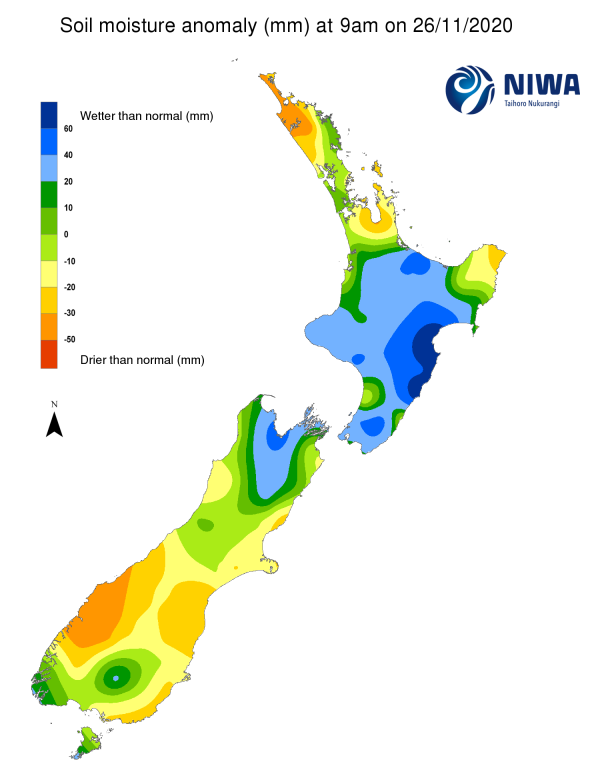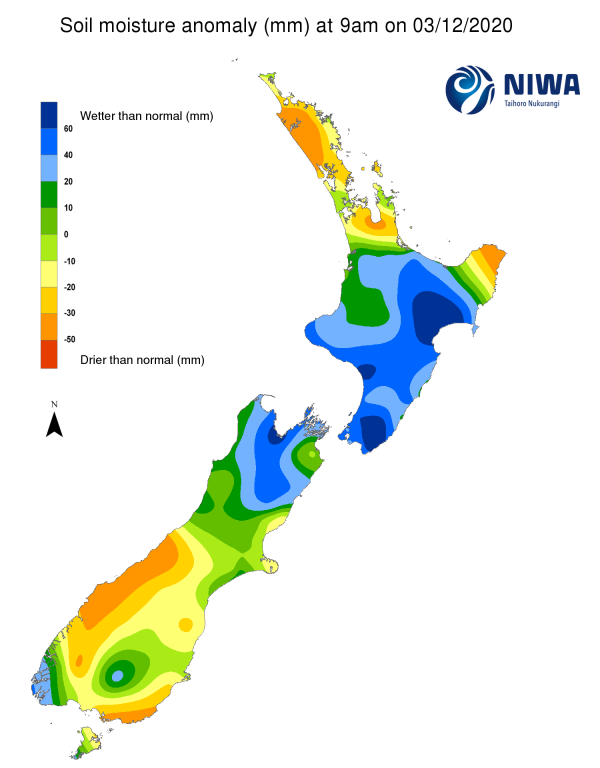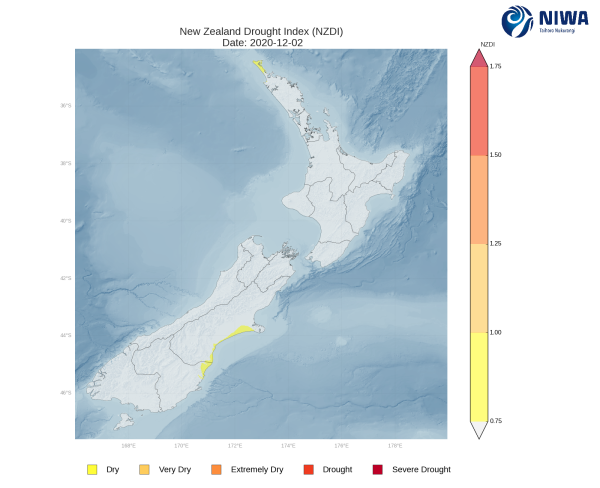A weekly update describing soil moisture patterns across the country to show where dry to extremely dry conditions are occurring or imminent. Regions experiencing significant soil moisture deficits are deemed “hotspots”. Persistent hotspot regions have the potential to develop into drought.
Facts: Soil Moisture
Significant rainfall amounts of 30-70 mm occurred in western Waikato, Taranaki, Wairoa District, and Wellington, during the past week, with a few locations in these areas receiving up to 100 mm. However, the remainder of the North Island generally received less than 25 mm, with parts of Northland observing less than 10 mm. This resulted in small to moderate soil moisture increases across most of the central and southern North Island. However, soil moisture decreases occurred from Northland to northern Waikato, as well as in East Cape. The driest soils across the North Island, when compared to normal for this time of the year, are now found in western Northland and Hauraki District. Meanwhile, the wettest soils for this time of the year are located in Hawke’s Bay and South Wairarapa.
A small hotspot is now in place in the western Far North District, with another in East Cape.
In the South Island, widespread heavy rainfall of at least 50-75 mm was observed throughout Tasman and the West Coast, with several areas receiving more than 100 mm. Moderate rainfall of 30 mm or more was also found in much of Nelson, Marlborough, interior Canterbury, and Queenstown-Lakes District. However, rainfall amounts were generally 25 mm or less in coastal Canterbury as well as much of Otago and Southland. Much of the South Island saw small to moderate soil moisture increases during the past week, also small decreases occurred from Clutha District to Invercargill. The driest soils in the South Island compared to normal for this time of the year are now located in Westland and coastal Clutha District to Invercargill, while the wettest soils for this time of the year are found in the vicinity of Nelson.
The previous hotspot found from around Timaru south to coastal Waitaki District has dissipated in the past week, and no official hotspots are currently found in the South Island.
Outlook and Soil Moisture
Light to moderate rain may pass over Northland and Auckland on Saturday, with only a few showers for the rest of the North Island. Dry weather is then expected on Sunday as high pressure moves overhead. Unsettled weather appears likely for parts of the western and lower North Island between Monday and Wednesday (7-9 December) as a fetch of moisture-rich air moves out of the subtropics. Although it is too early to know precise amounts and locations for the heaviest rain, some areas will likely see substantial rainfall accumulations on these days. Thereafter, high pressure will bring more dry weather on Thursday and Friday (10-11 December). Weekly rainfall totals could exceed 75 mm in parts of the western and lower North Island, with some locations perhaps receiving more than 100 mm. However, rainfall could be substantially lower in Hawke’s Bay, Gisborne, and the upper North Island, where weekly totals could be 25 mm or less.
Due to the expected rainfall over the next week, the western and lower North Island will likely see additional soil moisture increases. However, soil moisture decreases may occur in parts of Hawke’s Bay, Gisborne, and the upper North Island. This may result in strengthening of the hotspots in East Cape and Northland.
Saturday will feature some rain in the West Coast, with showers or thunderstorms in the lower South Island. Most of Sunday will be dry, before more rain arrives in the West Coast late in the day and overnight. The north and west of the South Island may see periodic rainy conditions between Monday and Wednesday (7-9 December), while Canterbury to Otago remain mostly dry. Late next week is likely to turn drier as high pressure arrives. Weekly rainfall totals may exceed 100 mm in much of the western South Island, with parts of Nelson and Marlborough receiving up to 50 mm. However, much of the eastern and lower South Island will receive less than 25 mm.
Soil moisture increases may be found in the West Coast and top of the South Island during the next week, but soil moisture decreases will be likely in Canterbury and Otago. This may result in the reappearance of hotspots in these regions.
Background:
Hotspot Watch: a weekly advisory service for New Zealand media. It provides soil moisture and precipitation measurements around the country to help assess whether extremely dry conditions are imminent.
Soil moisture deficit: the amount of water needed to bring the soil moisture content back to field capacity, which is the maximum amount of water the soil can hold.
Soil moisture anomaly: the difference between the historical normal soil moisture deficit (or surplus) for a given time of year and actual soil moisture deficits.
Definitions: “Extremely” and “severely” dry soils are based on a combination of the current soil moisture status and the difference from normal soil moisture (see soil moisture maps at https://www.niwa.co.nz/climate/nz-drought-monitor/droughtindicatormaps)
Hotspot: A hotspot is declared if soils are "severely drier than normal" which occurs when Soil Moisture Deficit (SMD) is less than -110 mm AND the Soil Moisture Anomaly is less than -20 mm.
Pictured above: Soil Moisture Anomaly Maps, relative to this time of year. The maps show soil moisture anomaly for the past two weeks.
New Zealand Drought Index (NZDI)
As of 2 December, the New Zealand Drought Index (NZDI) map below shows that drier than normal soils are located in Aupouri Peninsula and parts of the eastern South Island, but meteorological drought is not currently found in New Zealand. Please note: some hotspots in the text above may not correspond with the NZDI map. This difference exists because the NZDI uses additional dryness indices, including one which integrates the rainfall deficit over the past 60 days. Changes are therefore slower to appear in the NZDI compared to soil moisture anomaly maps that are instantaneously updated.




